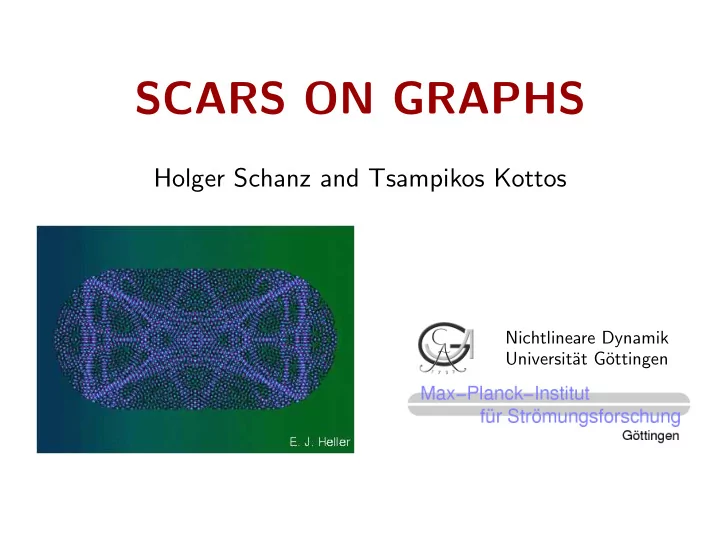

SCARS ON GRAPHS Holger Schanz and Tsampikos Kottos Nichtlineare Dynamik Universit¨ at G¨ ottingen
1 Deterministic Chaos vs Random Walk on a Graph 1
2 Quantum graphs: 1. Line h 2 d 2 − ¯ d x 2 Ψ ( x ) = E Ψ ( x ) 2m � h 2 k = 2mE / ¯ 2
3 Quantum graphs: 2. Vertex Neumann b.c.: ρ τ τ τ ρ τ · · · σ = τ τ ρ · · · · · · 2 τ = ≪ 1 ( v → ∞ ) a − = σ a + v 2 ρ = v − 1 ∼ − 1 ( v → ∞ ) - current conservation σσ † = I - continuity of wavefunction 3
4 Quantum graphs: 3. Network interpretation: discrete time evolution | ψ ( t ) � = U t ( k ) | ψ ( 0 ) � classical analogue: Markov chain U d ′ , d ( k ) = exp(i kL lm ) σ ( m ) M d ′ d = | U d ′ d | 2 ln d ′ = [ m → n ] d = [ l → m ] 4
5 A complete Graph 5
6 An “ergodic” eigenstate 6
7 A typical eigenstate 7
8 A scar on a graph 8
9 The inverse participation number 2B 2B � � | a d | 2 = 1 | a d | 4 < 1 I = d = 1 d = 1 1 1 1 0.1516 ≈ 1 1 2B = 0.0096 ≈ 380 104 6 2 9
10 IPN from return probability Heller ’84: scars ⇔ short-time dynamics: � � d | m � e − i ǫ m t � m | d � � d | U t | d � = m � |� m | d �| 2 |� n | d �| 2 � e i( ǫ m − ǫ n ) t � t � P d ( t ) � t = � �� � m , n δ m , n � P d ( t ) � t , d = � I m � m ⇒ average localization of eigenstates � 2B ∆ ǫ ∼ 2 π 1 ⇒ �·� t ∼ t = 1 2B 2B 10
11 Many ways to return ... e i kL 1 ρ e i kL 1 ρ e i kL 1 τ e i kL 2 τ e i kL 3 τ Neumann b.c., large graphs: τ = 2 / v → 0 ρ = τ − 1 → − 1 11
12 ... but only one is important Kaplan 2001: period-two orbits ⇒ � I � ∼ v × I RMT The shortest and most stable orbits cause enhanced localization. 12
13 Take-home message Weak scars � = Strong scars 13
14 Which orbits can scar? perfect scars: � j e i kL d a d 0 = 0 + τ d ∈ D ( − ) j , p p v j , p ≥ 2 − δ v j , 1 ( ∀ j ∈ p ) Stability is irrelevant! D (+) j , p , D ( − ) D (+) D ( − ) j , p , � j , p , � j , p 14
15 Energies of scars? � e i kL d ′ a d ′ ( τ a d = + δ d ′ ˆ d [ ρ − τ ] ) d ′ ∈ D ( − ) � �� � j , p � �� � − 1 0 j a d = − e i kL d a ˆ d d ^ a d = +e 2 i kL d a d d p kL d = m d π ∀ d ∈ p ⇒ commensurate bond lengths D (+) j , p , D ( − ) D (+) D ( − ) j , p , � j , p , � j , p L d / L d ′ = m d / m d ′ No perfect scars for generic graphs! 15
16 Perturbation theory for the scar quality P ( ε → 0 ) ∼ ε N − 2 � a ( 0 ) Φ | a ( 0 ) m | ˆ � scar � | a scar � = | a ( 0 ) | a ( 0 ) scar � + ε m � 1 − exp(i[ λ ( 0 ) m − λ ( 0 ) scar ]) m � =scar Scar quality: δ p = � ∈ p | a d | 2 d / (0 ≤ δ ≤ 1, δ p = 0: perfect scar) 16
17 Distribution of scars I ≥ 1 / 6 − δ/ 3 P ( N ) ( δ → 0 ) = C δ ( N − 3 ) / 2 cf Berkolaiko et al. (2003): No quantum ergodicity for P ( 2 ) ( δ → 0 ) ∼ δ − 1 / 2 star graphs. P ( 3 ) ( δ → 0 ) = C P ( 4 ) ( δ → 0 ) ∼ δ + 1 / 2 17
18 Conclusions • The scar theory of Heller et al. applies to graphs, ... • ... but it does not describe the scars ... • ... because strong and weak scarring are unrelated phenomena. • A detailed understanding of strong scars was achieved, ... • ... but the method does not (immediately) generalize to other systems. Phys. Rev. Lett. 90 (03) 234101. 18
Recommend
More recommend